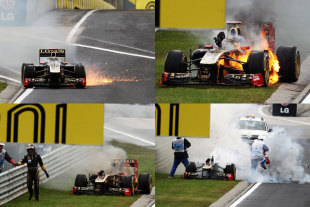- Renault news
Renault explains Heidfeld's fire

- Race:
- Hungarian Grand Prix
- Championship:
- FIA Formula One World Championship
- Drivers:
- Nick Heidfeld
- Teams:
- Renault
Renault has revealed that a cracked exhaust was to blame for Nick Heidfeld's fire at the Hungarian Grand Prix, and that the subsequent explosion was caused by an air bottle.
Heidfeld's Renault rolled to a halt in flames on lap 23 after he left the pits following a scheduled stop. He leapt from the wreck unharmed but due to fire damage and an explosion in the left sidepod, the team has revealed that the chassis has had to be written off.
"The incident was highly undesirable, as it has caused us to write off a chassis," technical director James Allison said. "We will take steps prior to the next race to reduce the likelihood of a further fire and to ensure that the air bottle cannot overheat. We are in touch with the FIA both to provide them with a full report of the incident and also to explain to them the actions we are taking to prevent a reoccurrence."
Allison explained that the combination of a number of factors had led to the fire, but ultimately it stemmed from a cracked exhaust.
"As with most accidents, several incidents combined to cause the fire that Nick suffered in Hungary," he said. "First of all, we ran a slightly different engine mapping strategy in qualifying, which produced hotter than normal exhausts. We believe that this elevated temperature and caused a preliminary crack in the exhaust pipe.
"We presume that the crack then propagated during the laps to the pit stop - this was not evident to us as we believe that the failure occurred upstream of the place where we have a temperature sensor. We believe that Nick then came in with a partially failed exhaust. This pit stop took longer than normal, the engine was left at high rpm for 6.3 sec, waiting for the tyre change to be completed. Under these conditions, a lot of excess fuel always ends up in the exhausts and their temperature rises at around 100°C/sec.
"This temperature rise was enough to finish off the partially failed pipe and to start a moderate fire under the bodywork."
He added that the explosion in the left sidepod "was caused by the air bottle which supplies the air valves in the engine. It has overheated in the fire and failed."

